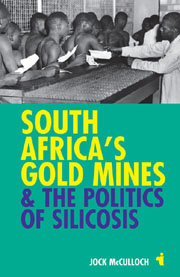Book contents
- Frontmatter
- Contents
- List of Photographs
- Preface: South Africa in the Twentieth Century
- Acknowledgments
- List of Abbreviations
- A Brief Chronology
- 1 Gold Mining & Life-Threatening Disease
- 2 Creating a Medical System
- 3 Compensation
- 4 A White Science
- 5 Myth Making & the 1930 Silicosis Conference
- 6 Tuberculosis & Tropical Labour
- 7 Conflict over the Compensation System
- 8 Healing Miners
- 9 The Sick Shall Work
- 10 Men Without Qualities
- Select Bibliography
- Index
Preface: South Africa in the Twentieth Century
Published online by Cambridge University Press: 05 February 2013
- Frontmatter
- Contents
- List of Photographs
- Preface: South Africa in the Twentieth Century
- Acknowledgments
- List of Abbreviations
- A Brief Chronology
- 1 Gold Mining & Life-Threatening Disease
- 2 Creating a Medical System
- 3 Compensation
- 4 A White Science
- 5 Myth Making & the 1930 Silicosis Conference
- 6 Tuberculosis & Tropical Labour
- 7 Conflict over the Compensation System
- 8 Healing Miners
- 9 The Sick Shall Work
- 10 Men Without Qualities
- Select Bibliography
- Index
Summary
On the eve of majority rule in 1990 the President of the Chamber of Mines K. W. Maxwell made some telling observations about South Africa. Per capita disposable income was falling and more than five million South Africans were unemployed. Half of the adult population was illiterate and half of the country's children were not attending school. South Africa had just 60,000 students in technical and higher education. With half the population Australia had over 800,000. Forty years of apartheid had denied most South Africans basic civil rights: it had also stunted the national economy. Maxwell was no doubt aware that the mines which had made the country the dominant industrial power on the continent had helped to create one of the world's most unequal societies.
The legacy inherited four years later by the newly-elected ANC government was every bit as daunting as Maxwell had suggested. South Africa had massive deficits in health care, housing, education and employment. The disparities between the rich and poor were among the highest in the world and they fell along the lines of colour which had so preoccupied minority governments.
South Africa's modern history lies at the convergence of two colonial systems, the British and the Dutch. Its transformation from a rural society to an industrial state at the end of the nineteenth century was accelerated by the discovery of diamonds near Kimberly in 1867 and gold at Johannesburg in 1886.
- Type
- Chapter
- Information
- South Africa's Gold Mines and the Politics of Silicosis , pp. xi - xviiPublisher: Boydell & BrewerPrint publication year: 2012



